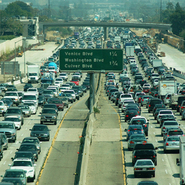California green lights tough low carbon car standards
 California on Friday approved some of the world’s most ambitious green car standards, with officials rubber-stamping a wide-ranging package of regulations that promises to halve greenhouse gas emissions and deliver 1.4 million zero emission vehicles to state roads by 2025.
California on Friday approved some of the world’s most ambitious green car standards, with officials rubber-stamping a wide-ranging package of regulations that promises to halve greenhouse gas emissions and deliver 1.4 million zero emission vehicles to state roads by 2025.The new regulations were voted through unanimously by the California Air Resources Board (ARB) and will build on nationwide standards approved last year by the Obama administration that require all new US cars to double average fleet fuel efficiency to 54.5 miles per gallon by 2025.
“The California Advanced Clean Car rules will clean our air, fight climate change and provide cars that save consumers thousands of dollars at the pump,” said ARB chair Mary D Nichols in a statement. “The board’s action today will create thousands of new jobs, transforming California into the advanced car capital of the world.
“California is now in pole position in the race to provide next-generation ultra-clean cars to the global car market.”
The rules include a series of standards and targets designed to cut both greenhouse gas emissions and the release of smog-forming particles and gases.
Manufacturers will be required to cut average carbon emissions to 166 grams per mile by 2025, an improvement of 50 per cent on current levels and 34 per cent on expected 2016 levels.
They will also have to cut emissions of smog-forming pollution by an additional 75 per cent on anticipated 2014 levels.
In order to help ensure the standards are met manufacturers will have to comply with a Zero Emissions Vehicle (ZEV) regulation that will require over 1.4 million zero emission cars and trucks to be on the state’s roads by 2025, while the state has also committed to ensure supporting refuelling infrastructure is built for electric and hydrogen cars.
According to ARB, the rules will save Californian drivers $5bn in operating costs by 2025 with each driver saving an average of nearly $6,000 in reduced fuel costs over the life of a car. The standards are also expected to cut greenhouse gas emissions by 52 million tons by 2025, equivalent to taking 10 million cars off the road for a year.
California has historically set vehicle emissions standards that other states have chosen to follow. Currently 14 other states, have adopted California’s smog emissions standards and 10 states have adopted its previous clean vehicle standards, fuelling hopes that a number of states could pick up the new standards.
Significantly, leading auto firms, including Ford, GM and Nissan, have come out in support of the new standards.
Green groups were also broadly supportive, although some critics warned that a “loophole” that allows firms to reduce the number of zero emission vehicles they have to make if they exceed average fleet emission standards could hold back investment in the greenest vehicle technologies.
Officials countered that this system of tradeable credits is intended as a transitional arrangement and will only apply between 2018 and 2021, after which all firms will have to comply directly with emission standards and targets for producing zero emission vehicles.
You can return to the main Market News page, or press the Back button on your browser.

